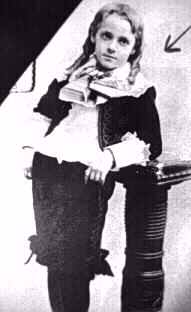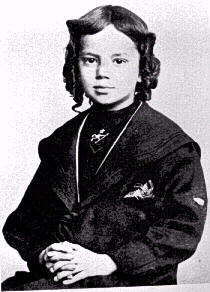
Figure 1.--Note the long sausage curls on this older boy which his mother has lovingly laid on his lace collar so they would be clearly visible. The picture was taken in the early 1890s.

Figure 1.--Note the long sausage curls on this older boy which his mother has lovingly laid on his lace collar so they would be clearly visible. The picture was taken in the early 1890s. |
Doting Victorian and Edwardian mothers kept their treasured sons
in dresses and long curls. As the 19th century passed boys were less frequently
kept in dresses and their hair was cut earlier. Some mothers, however, kept to
the traditional practices well into the 20th century.
Even after graduating to kilts or boyish suits such as sailor suits
and other
outfits such as little Lord Fauntleroy suits, a boy might be kept
in long-flowing curls.
Some mothers might wait until a boy was 10 or
even 11 before allowing him to have his long curls cutting.
Romantically inclined mothers, influenced by English-American
authoress Francis Hobson Bennett, kept their sons in curls, a
fashinoable statement
when wearing Little Lord Fauntleroy suits or other fancy clothes such
as kilts.
Many mothers had delayed cutting their sons hair before the
publication
of Mrs. Bennett's instantly popular, a least among
mothers, Little Lord Fauntleroy in 1886. After publication,
however, it not only became more popular to delay
cutting a boy's hair, it became fashionabe to curl it. Boys' in long
fashionable curls, sometimes boys as old as 10 or 11 could be seen.
Many reports exist of boys
kept in curls well into their boyhood.
Franklin Roosevelt
in the 1880s who
was raised at home wore dresses, kilts, and Fautleroy suits crowed with carefully
maintained curls.
These boys had to endure having their hair done up in papers at night to make curls just like their sisters. It was at the time a long drawn out process which presumably must have been irritating for an active boy with surely many more pressing ideas of how he could spend his time. Some authors have wondered about the impact of wearing curls on the boy's psyche. Some have wondered which was more objectionable the curls or the >
It was always a major rite of passage for a boy to finally have his curls cut and allowed to wear more closely cropped hair. While long hair for boys in the 1960s became very fashionable, it was certainly never curled. In previous years, however, long hair, even uncurrled long hair, was generally perceived as girlish. As a result many a boy looked forward with great relish to have his locks trimmed. For many a doting mother, however, it was often a trying experience bringing forth gushing tears and the site of herdarling sons flowing curls falling to the floor. Many mothers would save the clipped curls as keepsakes. Franklin Roosevelt's mother, for example, kept her son's curls in a trunk with his baby dresses and other keepsakes as long as she lived.
Curls for boys continued into the 20th Century, but became increasingly uncommon. While unusual,

Figure 3.--Although unusual for the 1920s, noted author Thomas Wolfe's mother insisted on long sausage curls. Mercifully an Uncle took him at 9 years of age to the barber for a hair cut. |
Long hair for boys became fashionable again in the late 1960s. The hair style
Jacki chose for
John John helped to popularize bangs, although she was critcised in many
quarters for her son's hair cut and she eventually had it trimmed.
Eventually of course the Beatles helped to popularize longer hair among boys themselves.
Related Links
Navigate the Boys' Historical Clothing Web Site:
[
Introduction]
[
Chronology]
[
Clothing styles]
[
Biographies]
[
Bibliographies]
[
Contributions]
[
Boys' Clothing Home]